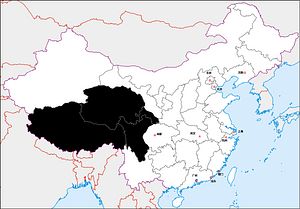This article series explores 12 distinct “regions” within China: six “core” regions long dominated by the majority Han ethnic group and six “periphery” regions home to many of China’s ethnic minorities. The series overview is available here. To view the full series, click here.
Aptly called the “third pole” and “roof of the world,” the Tibetan plateau has an average elevation exceeding 4,500 meters above sea level. Enclosed by the world’s tallest mountain ranges, its 2.5 million square kilometers is mostly arid steppe, much of which is under permafrost. Until recently a large proportion of the population was at least semi-nomadic, but a large-scale resettlement program is rapidly changing the region’s demographic complexion.
Qinghai province in the plateau’s northeast has large populations of Hui and Mongols as well as Tibetans, and boasts China’s largest lake, the location of the nation’s first nuclear weapons facility. Qinghai’s Qaidam basin contains large mineral, oil, and gas reserves.
The source of Asia’s ten biggest river systems, the plateau’s glaciers are melting at a rate that may see two-thirds disappear by 2050, threatening water supplies for two billion people. Dam building on the Tibetan stretches of these rivers has amplified concerns about unforeseen ecological consequences and the potential weaponization of water. China’s unresolved territorial dispute with India also makes this region a candidate for flashpoint of the next great power war, with this article being published during an increasingly severe standoff between the two at the Bhutan-China-India triborder region.
The plateau was unified in the early 600s as a militaristic empire that waged frequent wars against China, but Buddhism entrenched itself over the following centuries. From the mid-1200s, Tibet’s theocrats gained spiritual influence over their Mongol conquerors, with one khan bestowing on the Gelugpa sect’s chief the title Dalai Lama. They maintained a similar priest-patron relationship with China’s Ming and Qing emperors, the latter represented by an imperial resident in Lhasa until the empire’s dissolution in 1912. Tibet’s de facto independence ended in 1950 with the People’s Liberation Army’s arrival; the spread of a CIA-supported guerrilla movement led to the 1959 crackdown, the Dalai Lama’s flight into exile, and establishment of the Tibet Autonomous Region (TAR) corresponding to the old Lhasa-governed region of Ü-Tsang. The more distant ethnic Tibetan lands of Amdo and Kham were incorporated into Qinghai, Sichuan, and Yunnan provinces.
China’s fourth poorest province per capita, the TAR is also the nation’s most heavily subsidized region, with the central government pumping in over $46 billion from 1952 to 2010. Improved access through modern infrastructure, including the world’s highest railway, has promoted the rise of “Tibet chic” among China’s nouveau riche traveling class.
But as in other minority regions, development gains have been undermined by discontent over uneven access to opportunity, Han in-migration, and controls on religious practice; violent riots in 2008 by ethnic Tibetans have been followed by a spate of protests through self-immolation. Despite the ambiguity raised by the Dalai Lama over his reincarnation, Beijing has made clear that the institution will continue.
Next up: China’s Southwest.
John Lee is a former visiting fellow of the Mercator Institute for China Studies. He tweets at @J_B_C16.

































